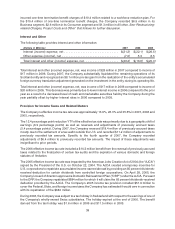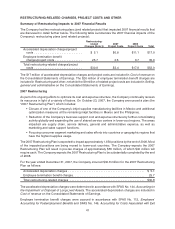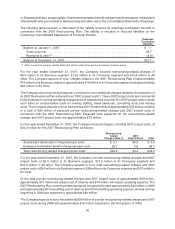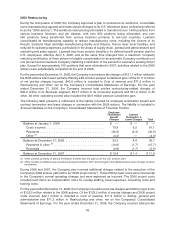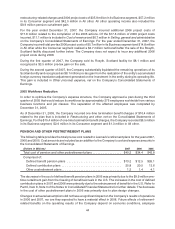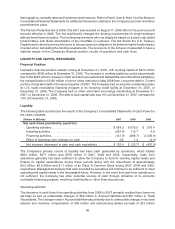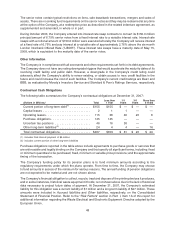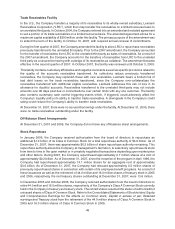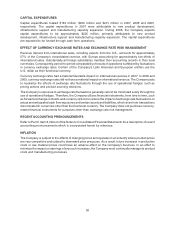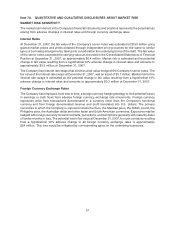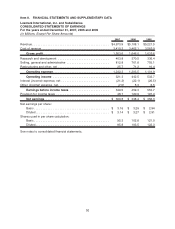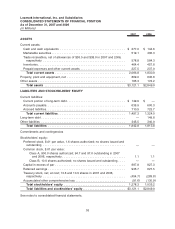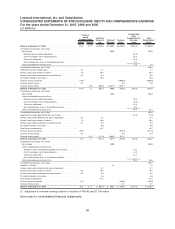Lexmark 2007 Annual Report Download - page 55
Download and view the complete annual report
Please find page 55 of the 2007 Lexmark annual report below. You can navigate through the pages in the report by either clicking on the pages listed below, or by using the keyword search tool below to find specific information within the annual report.Trade Receivables Facility
In the U.S., the Company transfers a majority of its receivables to its wholly-owned subsidiary, Lexmark
Receivables Corporation (“LRC”), which then may transfer the receivables on a limited recourse basis to
an unrelated third party. In October 2004, the Company entered into an amended and restated agreement
to sell a portion of its trade receivables on a limited recourse basis. The amended agreement allows for a
maximum capital availability of $200 million under this facility. The primary purpose of the amendment was
to extend the term of the facility to October 16, 2007, with required annual renewal of commitments.
During the first quarter of 2007, the Company amended the facility to allow LRC to repurchase receivables
previously transferred to the unrelated third party. Prior to the 2007 amendment, the Company accounted
for the transfer of receivables from LRC to the unrelated third party as sales of receivables. As a result of
the 2007 amendment, the Company accounts for the transfers of receivables from LRC to the unrelated
third party as a secured borrowing with a pledge of its receivables as collateral. The amendment became
effective in the second quarter of 2007. In October 2007, the facility was renewed until October 3, 2008.
This facility contains customary affirmative and negative covenants as well as specific provisions related to
the quality of the accounts receivables transferred. As collections reduce previously transferred
receivables, the Company may replenish these with new receivables. Lexmark bears a limited risk of
bad debt losses on the trade receivables transferred, since the Company over-collateralizes the
receivables transferred with additional eligible receivables. Lexmark addresses this risk of loss in its
allowance for doubtful accounts. Receivables transferred to the unrelated third-party may not include
amounts over 90 days past due or concentrations over certain limits with any one customer. The facility
also contains customary cash control triggering events which, if triggered, could adversely affect the
Company’s liquidity and/or its ability to transfer trade receivables. A downgrade in the Company’s credit
rating could reduce the Company’s ability to transfer trade receivables.
At December 31, 2007, there were no secured borrowings under the facility. At December 31, 2006, there
were no trade receivables outstanding under the facility.
Off-Balance Sheet Arrangements
At December 31, 2007 and 2006, the Company did not have any off-balance sheet arrangements.
Stock Repurchase
In January 2006, the Company received authorization from the board of directors to repurchase an
additional $1.0 billion of its Class A Common Stock for a total repurchase authority of $3.9 billion. As of
December 31, 2007, there was approximately $0.3 billion of share repurchase authority remaining. This
repurchase authority allows the Company, at management’s discretion, to selectively repurchase its stock
from time to time in the open market or in privately negotiated transactions depending upon market price
and other factors. During 2007, the Company repurchased approximately 2.7 million shares at a cost of
approximately $0.2 billion. As of December 31, 2007, since the inception of the program in April 1996, the
Company had repurchased approximately 74.1 million shares for an aggregate cost of approximately
$3.6 billion. As of December 31, 2007, the Company had reissued approximately 0.5 million shares of
previously repurchased shares in connection with certain of its employee benefit programs. As a result of
these issuances as well as the retirement of 44.0 million and 16.0 million shares of treasury stock in 2005
and 2006, respectively, the net treasury shares outstanding at December 31, 2007, were 13.6 million.
In December 2005 and October 2006, the Company received authorization from the board of directors to
retire 44.0 million and 16.0 million shares, respectively, of the Company’s Class A Common Stock currently
held in the Company’s treasury as treasury stock. The retired shares resumed the status of authorized but
unissued shares of Class A Common Stock. Refer to the Consolidated Statements of Stockholders’ Equity
and Comprehensive Earnings for the effects on Common stock,Capital in excess of par,Retained
earnings and Treasury stock from the retirement of the 44.0 million shares of Class A Common Stock in
2005 and 16.0 million shares of Class A Common Stock in 2006.
49


